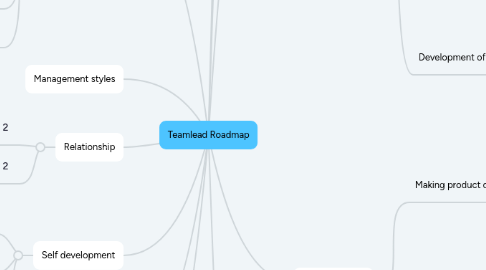
1. Communication
1.1. Conflicts management
1.2. Engagement and cooperation
1.3. Group discussions
1.4. Giving and receiving feedback
1.5. Networking
1.6. Personal brand
1.7. Public speeches
1.8. Text work
2. Management styles
3. Relationship
3.1. Understanding of differences value
3.2. Emotional intellect
4. Self development
4.1. Habits work
4.2. Learning abilities
4.3. Reflexion
5. Thinking
5.1. Decision making
5.2. Strategic vision
6. Time-management
6.1. Personal goals
6.2. Priority management
6.3. Time management
7. Administrator
7.1. Development cycle building
7.1.1. Development
7.1.1.1. Ready to go approaches
7.1.1.1.1. Lean
7.1.1.1.2. Scrum
7.1.1.2. Methodology construction
7.1.2. Receiving tasks
7.1.3. Giving tasks
7.1.3.1. Accepting tasks
7.1.3.2. Roll-out
7.2. Project management
7.2.1. p3express
7.2.2. PDCA
7.2.3. PMBoK
7.3. Stack holding
8. Integrator
8.1. Business knowledge
8.2. Company structure
8.3. Corporate culture
9. People Manager
9.1. Individuals management
9.1.1. Administrative work
9.1.2. Delegation
9.1.3. Growth
9.1.4. Feedback
9.1.5. Dismissal
9.1.6. Employment
9.1.6.1. Interviews
9.1.6.2. Onboarding
9.1.6.3. Candidate profile
9.1.6.4. Trial period
9.1.7. Motivation
9.1.8. One-to-one
9.1.9. Promo
9.1.9.1. Assesment
9.1.9.2. Career development
9.2. Team management
9.2.1. Competency management
9.2.2. Team climate
9.2.3. Team design
9.2.4. New teams creation
9.2.5. Team maturity
9.2.6. Transparency insurance
9.2.7. Organization of work place
9.3. Development of a Tech Brand
10. Product Owner
10.1. Making product decisions
10.1.1. Goals planning
10.1.2. Management of product logs
10.1.2.1. Generating Backlog Items
10.1.2.2. Backlog prioritisation
10.1.3. Product strategy
10.1.4. Roadmaps
10.2. Product lifecycle
10.2.1. Features lifecycle
10.2.2. Product readiness
10.3. Product understanding
10.3.1. Market knowledge
10.3.2. Product knowledge
10.3.3. User knowledge
11. Technical Lead
11.1. Architecture
11.1.1. Architecture review
11.1.2. Architecture design
11.1.3. Development
11.1.4. Technical requirements
11.2. Automatisation of dev cycle
11.2.1. Continuous Integration
11.2.2. Automatisation of releases
11.2.3. Version control
11.3. Capacity Management
11.4. Knowledge Management
11.4.1. Technical Documentation
11.4.2. Knowledge sharing
11.5. Product Quality Assurance
11.5.1. Bugs and fixes Flow
11.5.2. Code review
11.5.3. Incidents management
11.5.4. Metrics and monitoring
11.5.5. Non-functional requirements
11.5.6. Testing
11.5.6.1. Non-functional testing
11.5.6.2. Tests of design
11.5.6.3. Optimisation of testing amount
11.5.6.4. Testing planning
11.5.6.5. Testing pyramid
11.5.6.5.1. Auto tests of API
11.5.6.5.2. Auto tests of GUI
11.5.6.5.3. Unit-tests
11.5.6.6. Requirements testing
11.6. Technology Knowledge
11.6.1. Code writing
11.6.2. Choice and control of tech stack
11.6.3. Knowledge of team tech stack
11.7. Ensuring technical quality
11.7.1. Clean code
11.7.2. Refactoring
11.7.3. Technical debt management
